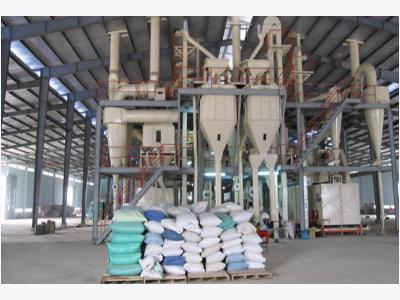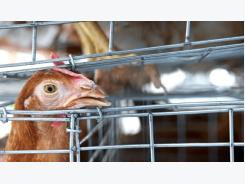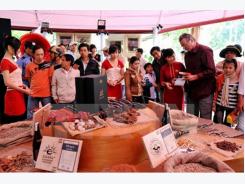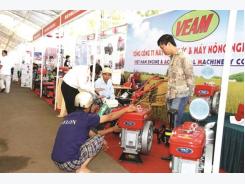Foreign feed producer oligopoly destroys livelihood of shrimp farmers

Exorbitant feeding costs account for two thirds of production expenses. Farmers’ incomes are merely enough to pay debts.
The target to reach $10 billion in shrimp exportation would lose its meaning if the majority of the profit continues to flow into the pockets of foreign invested shrimp feed production enterprises, while farmers are still struggling on the brink of insolvency.
Penniless farmers and fattening sales agents
Used to investing billions in shrimp farming, head of Thoi An Fisheries Cooperative (in O Mon, Can Tho) Nguyen Ngoc Hai must give up farming after losing $220,000 last year.
According to Hai, “shrimp farming is a very demanding job, as the whole farm can die of diseases in just a matter of hours and only by raising shrimp for at least 60-70 days can farmers make any profit.”
Overpriced shrimp feed and the multitude of middlemen between factories and farmers have essentially turned farmers into non-paid labourers.
The wholesale price of shrimp feed in factories is approximately $0.96 per kilogramme, yet after going through three or four middlemen, the price can go up to $1.32 per kg.
That shrimp feed enterprises (mostly foreign) pay high commissions for sales agents who then raise prices and make billions at the expense of farmers has been confirmed by the authorities.
Deputy director of the General Fisheries Bureau under the Ministry of Agriculture and Rural Development Nguyen Huy Dien admitted that according to inspection results in 2016, discounts and commissions of foreign invested shrimp feed production enterprises go up to 30 per cent.
Besides the high commission, companies also give agents expensive gifts, like cars.
Farmers found themselves at the losing end of an unfair game.
In the last two years, material costs for shrimp feed have been plummeting, yet prices have shown no signs of wavering and instead of lowering prices, foreign invested enterprises (FIEs) increase discounts for sales agents.
This explains why even though shrimp prices have increased, farmers did not get their hopes up for the next breeding season.
In 2014, shrimp exports reached $4 billion, but has decreased to $3 billion per year in the last two years.
“All the profits go to FIEs, while farmers barely make enough to pay their debts,” asserted Nguyen Huu Dung, president of the Vietnam Seaculture Association (VSA).
Overpriced shrimp feed also causes difficulty to shrimp exports as the current export price of Vietnamese shrimp is $1-2 per kg higher than that of Thailand, India or Indonesia.
Foreign feed makers’ methodical takeover

Vietnam’s total shrimp farming area is currently 700,000 hectares, with the quantity of 660,000 tonnes.
Based on this quantity, the demand for shrimp feed is 700,000-800,000 tonnes (worth approximately $1 billion).
If Vietnam is to achieve the target of $10 billion in shrimp exports in 2025, the demand for shrimp feed would need to go up to 2.1-2.4 million tonnes (approximately $3 billion).
This lucrative market is entirely in the palms of FIEs.
Owning almost 100 per cent of the market share, FIEs have many points of access to manipulate the market and raise prices. Farmers have no choice but bitterly go with the flow.
Most of the shrimp feed production giants have made their presence in Vietnam. Among them, Taiwanese and Chinese corporations like Grobest, Uni President, Asia Nutrition Technology Group, and Tongwei have the greatest sales and market share.
There are also many other corporations from Thailand (CP), Korea (CJ Master), France (Tomboy), and the US (Cargill).
According to seafood experts, foreign shrimp feed producers have many ways to attack the Vietnamese market.
The first way is a vertical offensive. FIEs can invest and gain control from the breeding segment to the feeding segment, forcing farmers into complete dependence.
The second way is to invest heavily in consultancy services (by sending consultants to each farm), demonstrations, promotions, marketing, and sales agents. In this way, FIEs expand their networks to almost every single farm.
For example, Uni President Vietnam has invested $2.7 million in breeding. The enterprise’s strategy is to combine shrimp feed production with breeding farms and frozen processing factories.
Uni President Vietnam currently has the highest investment from Uni President Corporation in Southeast Asia.
Through this Vietnamese subsidiary and others in Taiwan and China, the group is aspiring to form a steady foothold in Asia.
Though Uni President Vietnam has not announced its profit, the fact that it continuously builds new factories and expands the scale of production indicates extreme prosperity.
According to official data published on the Uni President Vietnam website, its revenue increased by 30-60 per cent between 2004 and 2007, a dream of every business.
CEO Nguyen Trong Huy of TomKing Aquatic Feedmill Corporation , one of the rare domestic enterprises remaining on the market, stated that, “The profit rate in this industry is very high. FIEs’ many advantages in capital access, cheap materials, and experience boosts this income rate even higher.”
With sizeable early investment, well thought-out strategy, and unique advantages, FIEs are manipulating the market, sparing barely any room for domestic competitors.
At present, TomKing and Proconco (former FIEs) are two of the few domestic names on the market.
Even when shrimp exports reached the $10 or 20 billion mark, the majority of the profit will still flow into FIEs’ pockets, while farmers get next to nothing for their hard work.
“If this situation persists, can Vietnam really succeed in becoming the world’s shrimp factory?” asked Huy with genuine worry.
Related news
Tools

Phối trộn thức ăn chăn nuôi

Pha dung dịch thủy canh

Định mức cho tôm ăn

Phối trộn phân bón NPK

Xác định tỷ lệ tôm sống

Chuyển đổi đơn vị phân bón

Xác định công suất sục khí

Chuyển đổi đơn vị tôm

Tính diện tích nhà kính

Tính thể tích ao









 Tra fish price peaks on…
Tra fish price peaks on…  Vietnam tuna shipment targets to…
Vietnam tuna shipment targets to…